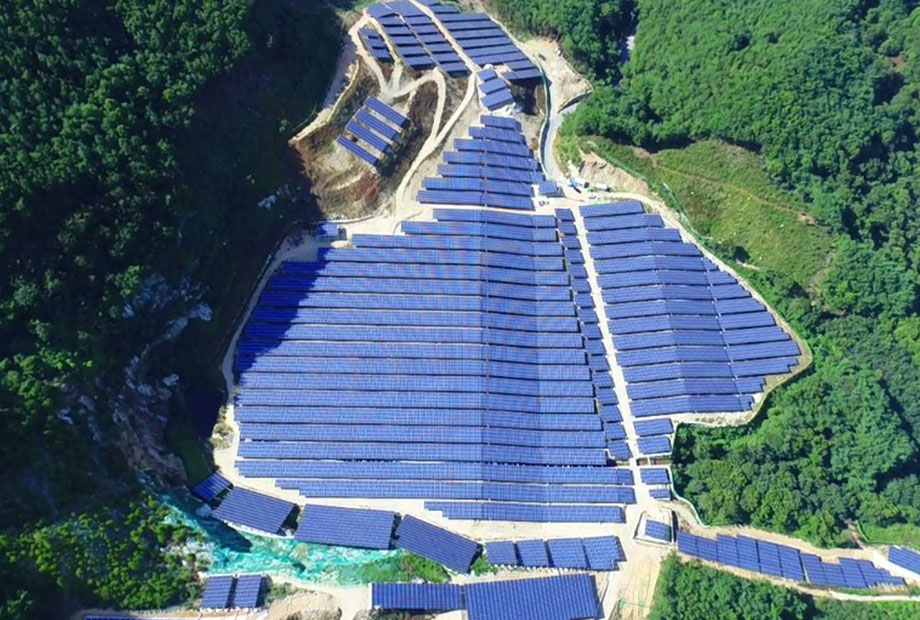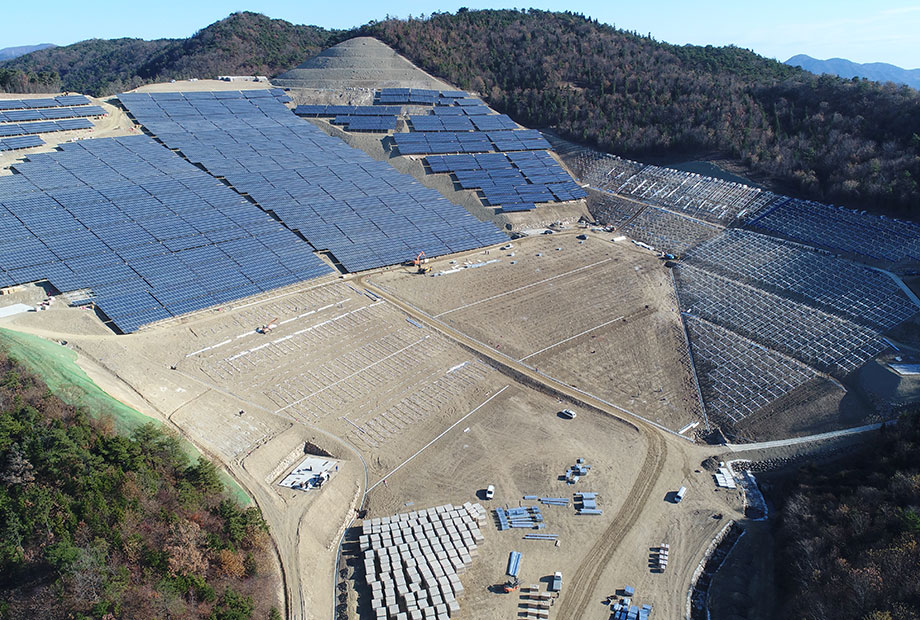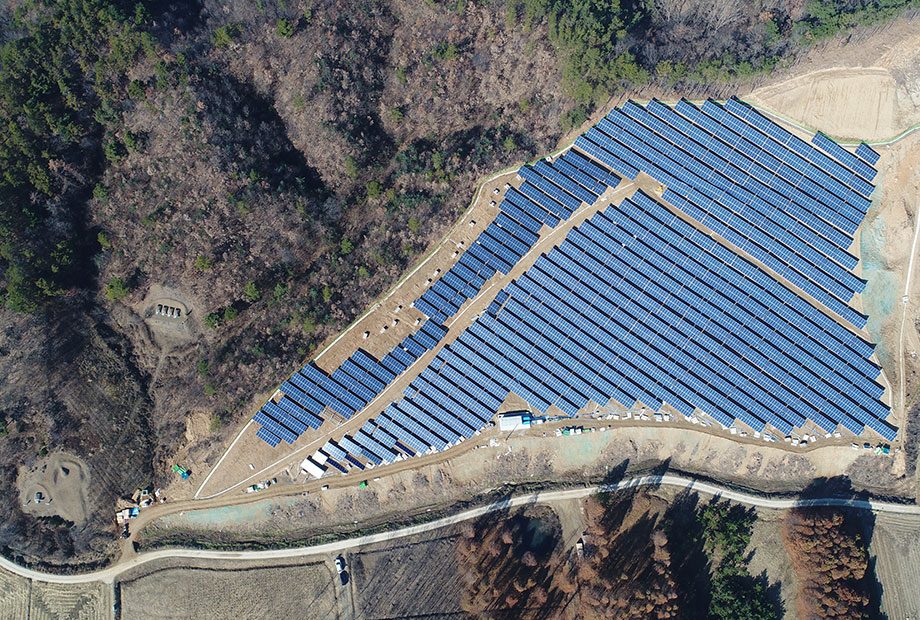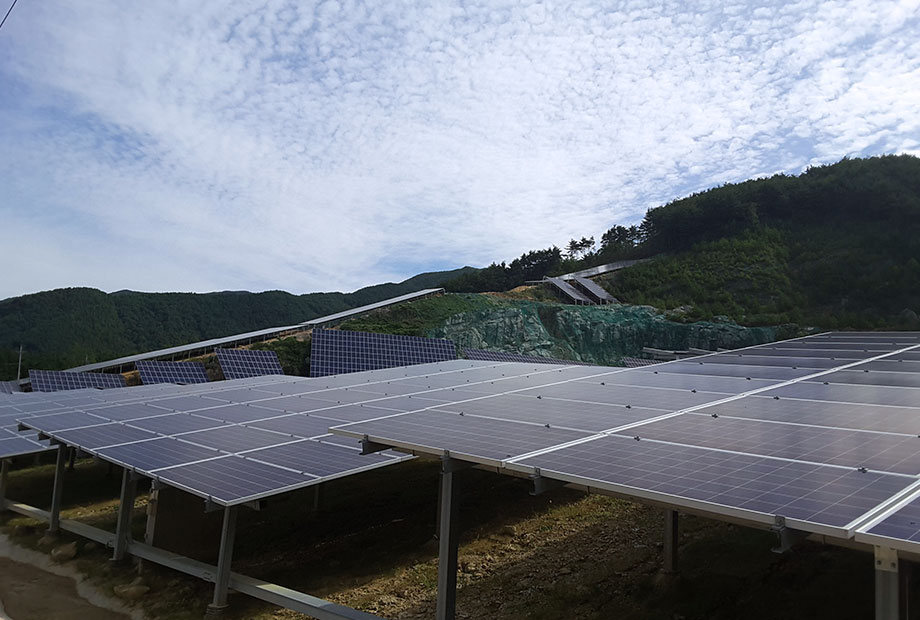ESS(Energy Storage System)
What is ESS?
ESS is an installation that saves generated power in batteries and supplies (discharges) it when necessary to increase energy efficiency.
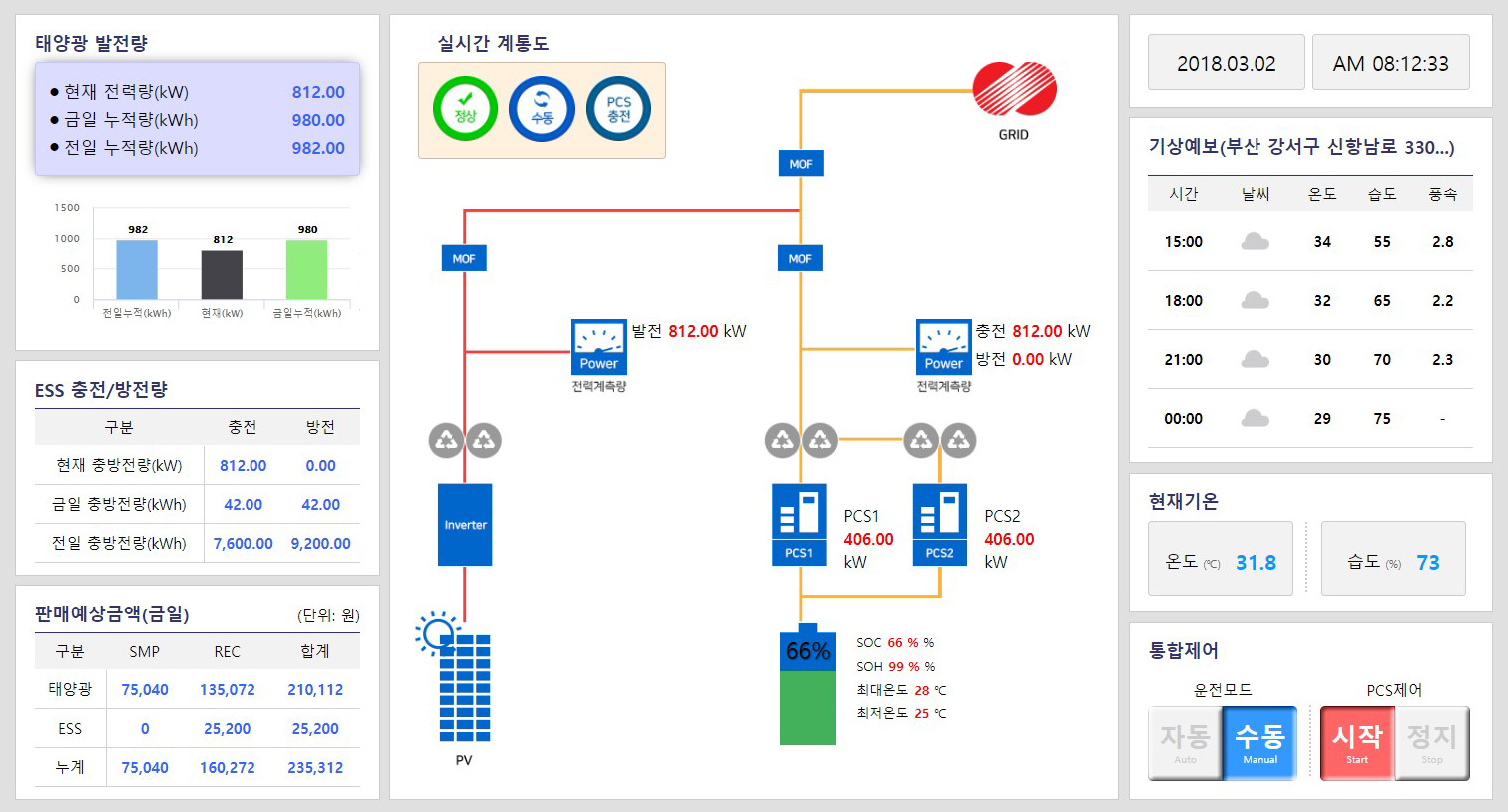
Current state of domestic ESS market and forecast
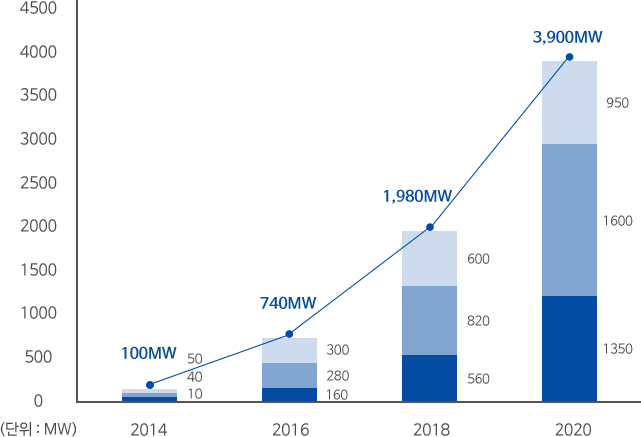
- New renewable power
- Peak
- Frequency
- ▶ Rapid growth of ESS market through the application of a REC modifier of 5.0
- ▶ New renewable power generation sector (2014~2020 forecast)
- - Ratio within ESS : 10% → 34.6% growth
- - Installed capacity : 10MW → 1,350MW
- 1 Composition of ESS market (by use)
-
New renewable power generation - For solar/wind power stations
- Sector expected to become core business of this company
Peak time reduction - For reducing a factory’s power consumption during peak times
- Expected to be a secondary development for this company, and there are plans to expand market through cooperation with Sebang Global Battery
Frequency adjustment - For compensating for unstable electrical power frequencies resulting from new renewable power sources possessed by an electric power subsidiary
- Business to begin through bidding
- 2 Supply and demand issues for ESS batteries
-
2017 Due to supply issues with raw materials such as cobalt and lithium, in addition to increasing demand for electric car batteries, insufficient supply of lithium ion batteries. 2018 As the supply of ESS batteries is expected to be insecure until the latter half of the year, this will be an important variable in the growth of the ESS market. ※ Besides SDI/ LG Chem, in the middle of cooperating with Sebang Global Battery, biz expansion
Constructing an ESS (Energy Storage System) and a new renewable power station together increases profits by storing energy in the storage equipment during periods of power generation then transmitting this power during periods of non-generation in order to sell with a high REC modifier.


- PCS(Power conversion system)
-
- Converts generated electrical power into an electrical form suitable for charging/discharging (AC ← → DC, current, frequency, etc.)
- BATTERY(Power storage system)
-
- Stores (charges) the electrical energy received from the system or transmits (discharges) electrical energy to the system
- Formed of BMS, cell, module, rack
- PMS (Power monitoring system)
-
- Monitoring/control of batteries and PCS status
- Transmits/receives ESS status information to/from the upper level (EMS) (control commands, monitoring control)
ESS connected to solar
- A REC modifier of 5.0 applies only to electricity discharged during times at which electricity is not being generated
- Mitigates a lack of accessible capacity that results from daytime power generation (increased capacity connected to the system), and can meet high nighttime demand during the Spring, Fall, and Winter
Profits for a new ESS electric power business
Amount discharged by ESS *{monthly SMP weighted average + new REC contract price * 5.0} – amount charged by ESS *{monthly SMP weighted average + existing REC contract price * existing REC modifier}
| Category | Energy and standards | Supply certification modifier | Notes | ||
|---|---|---|---|---|---|
| Category | Standard in detail | Current | After amendment | ||
| Solar | Standard plot (excluding forests and fields) |
Less than 100kW | 1.2 | Current value maintained | - |
| From 100kW onwards | 1.0(mixed) | Current value maintained | - | ||
| Above 3,000kW | 0.7(mixed) | Current value maintained | - | ||
| Forests and fields | 0.7 ~ 1.2 | 0.7 | Deferment period set *1 | ||
| Using a structure | 3,000kW and below | 1.5 | Current value maintained | ||
| Above 3,000kW | 1.0(mixed) | Current value maintained | |||
| Offshore solar | 1.5 | Current value maintained | |||
| Automobile solar | 1.0 | Current value maintained | |||
| Wind | Onshore wind | 1.0 | Current value maintained | ||
| Offshore wind | Connection distance 5km or less | 1.5 | 2.0 | Immediately applied | |
| Connection distance 5~10km | 2.0 | 2.5(mixed) | |||
| Connection distance 10~15km | 3.0(mixed) | ||||
| Connection distance greater than 15km | 3.5(mixed) | ||||
| ESS | Connected to wind power installation | 4.5(June 2018) | 4.5 (2018 ~ 2019) 4.0 (2020) |
Immediately applied | |
| Connected to solar power installation | 5.0(June 2018) | 5.0 (2018 ~ 2019) 4.0 (2020) |
Immediately applied | ||
*1 Deferment period for forest and field solar
- For businesses that will complete their development action approvals within 6 months of the notice amendment date, current standard plot modifiers applied
- When solar + ESS is installed
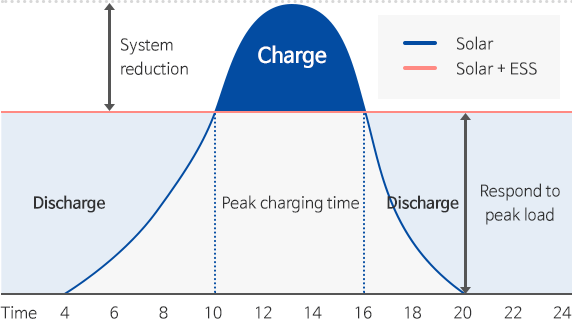
Electricity is stored by charging during the middle of the night when prices are low, and the stored electricity is used during peak hours to reduce electricity bills.


- Drop during peak time (Base fee savings)
-
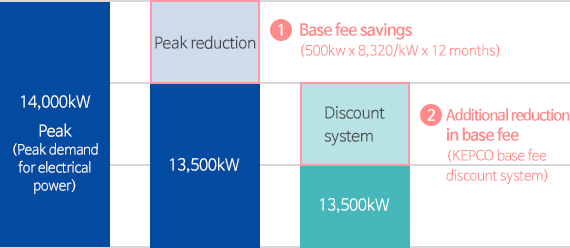
Reduction in maximum amount of power used (peak power) due to use of ESS power during periods of maximum load (peak hours)
- Critical Peak Pricing (CPP) base fee reduction
-
- Critical peak pricing (CPP) imposes base fees based on the maximum power (kW) spike during the peak load period.
- Reduction in the maximum peak for the base fee that is imposed based on the maximum peak (=power for which fees apply) among December, January, February, July, August, and September of the 12 months immediately preceding the month in which the examination is being conducted, including the present month.
※ Maximum peak X base fee unit cost = base fee
- Alternate power for maximum load (Usage fee savings)
-
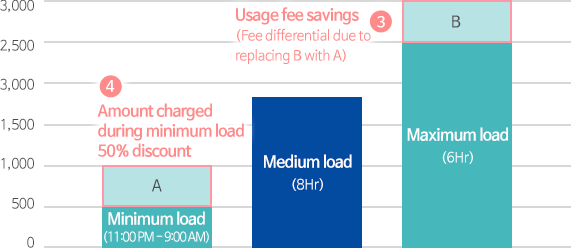
Charge during the minimum load period, when the unit cost of the usage fee is at its cheapest, and use as an alternative source of power during the maximum load period, when the unit cost is at its highest.
- Reduction in usage fee
-
- Usage fees based on time (TOU, Time-Of-Use) Watt-hour (kWh) fee differences between minimum load, medium load, and maximum load periods.
- Fee differential resulting from charging cheap energy during minimum load periods and supplying it during the maximum load period, when fees are most expensive.
Microgrid
- ESS Configuration - Battery, PCS, EMS
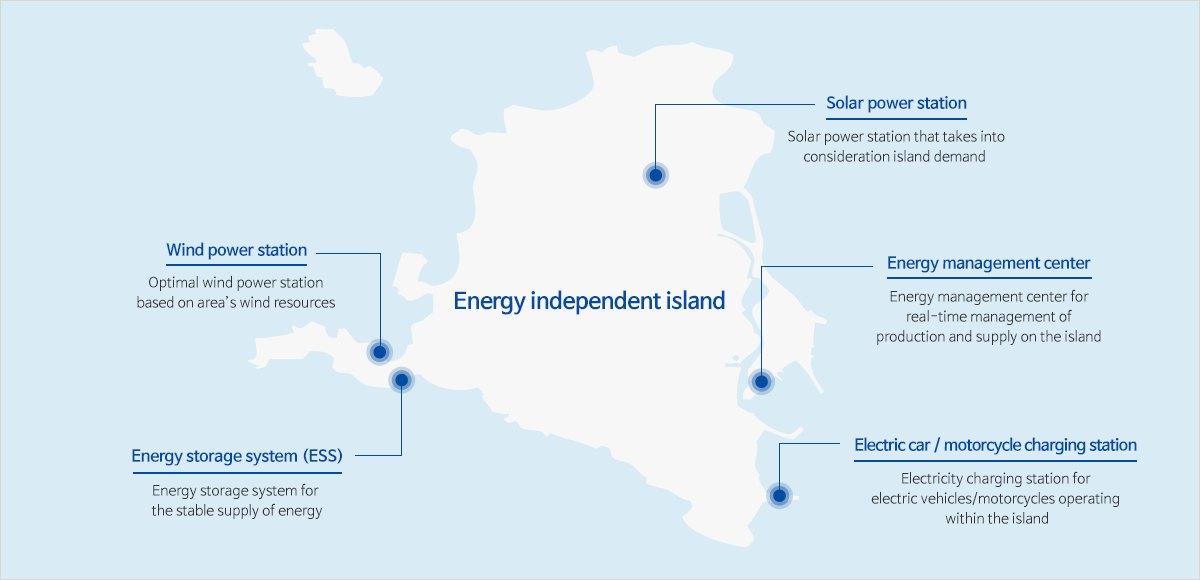
Examples
Main ESS achievements
-
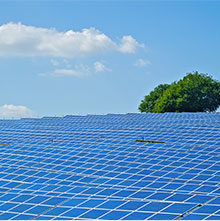 Skyfarm Solar Solar ESS constr
9MW
Skyfarm Solar Solar ESS constr
9MW
-
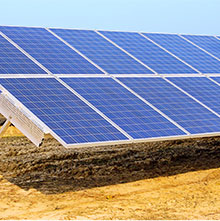 Mungyeong Future Solar ESS con
4MW
Mungyeong Future Solar ESS con
4MW
-
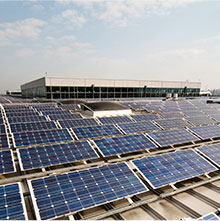 Jangseong Neungsung Solar ESS
4MW
Jangseong Neungsung Solar ESS
4MW
-
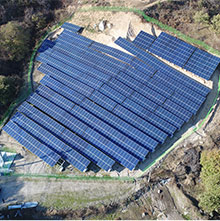 Jangseong Purunsol CC Solar ES
1MW
Jangseong Purunsol CC Solar ES
1MW

